- September 1, 2020
- By Reno Jackson
- In Articles, Guest Post, Meta Reports
- No Comment
- 0
Team WildSide Wild Meta Report (August 2020)
Welcome to Scholomance Academy, where fairness is against the rules and diversity is consigned to oblivion; where Rexxar is only a name in history textbooks and Illidan is a retired Soulciology instructor.
We would like to thank these top legend players who have given us their expert opinions and helped with writing the report: RenoJackson, Jonahrah, Hijodaikan, SgtSlayer, EpigPlayer, Memnarch, xtuliop, Goku, Niko, Beeozan, Malekith, and Duwin. Their Twitters are to be listed at the end of the report.
As we write without any monetary support, we need your support to keep on writing meta reports for the foreseeable future. If you really like the report and want us to keep going, please consider becoming a Patron here: https://www.patreon.com/thewildside
To get updates on all our future reports, consider joining our Discord server The Wild Side: https://discord.gg/FVZgtVs
Welcome to the Third Edition of Team WildSide’s Wild Meta Snapshot for 2020! We are teaming up with Hearthstone-Decks to provide you the most accurate Wild report possible.
In this meta report, we will be going through a tier list of 39 decks we’ve seen frequently on ladder, explain the method of computing the tier list, break down the meta and analyze the decks as detailed as they need to be. In this report, we have included a Meta Ranking and will be further discussing the state of each class in terms of power and diversity. Also, we’re including some WildSide special decklists that were made by none other than our experts!
METHOD
We collected our experts’ opinions through a spreadsheet, where our Top Wild legend players will rate the given decks with a corresponding score from 1 to 4 in increments of 0.5 (with 1 being top Tier 1 and 4 being bottom Tier 4). We then collect the result, standardize and categorize them in 4 different Tiers. This is what they mean:
Tier 0 (Absolute oppression)
The one deck to beat. You either play it or play decks that can beat it.
Tier 1 (Meta-defining)
Highly-optimised decks with extreme raw power that are very well positioned in the meta.
Tier 2 (High-legend viable)
Competitive decks that are not as well-rounded, but can snatch games off of Tier 1 decks or prey on their direct counters.
Tier 3 (Legend-viable)
Fringe decks that can capitalise on pocket metas that allow it, however, are either suboptimal or outmeta.
Tier 4 (Average)
Decks at a weaker power level that require an extensive understanding to be able to pilot well, however, are not recommended for ladder experience.
Tier 5 (Meme)
Decks that aren’t typically played to get for the purpose of climbing ladder, but still have a decent enough presence to be included in the report.
Within each tier, decks are categorized to either High tier, Mid tier or Low tier to further differentiate their power level.
For Meta Ranking analysis, we allocate points to each deck from Tier 0 to Tier 3 then sum them up. The point system for rating a single deck is as below:
Tier 0: 22
Tier 1: 18 (High), 15 (Mid), 12 (Low)
Tier 2: 9 (High), 7 (Mid), 5 (Low)
Tier 3: 3 (High), 2 (Mid), 1 (Low)
Each deck is also assigned a popularity ranking and a respective coefficient multiplier based on its popularity. The highest multiplier is 12 and the lowest is 7. For example, if Odd Paladin is High Tier 1 and has a multiplier of 12, it will bring the class an additional 216 points.
Therefore, a class can be placed highly on the Ranking system based on one (or both) of these elements: having a few strong decks (deck power) or having many decks (class diversity). If classes share the same score, the class with more top decks will be ranked higher.
REMARKS
Scholomance Academy has completely changed the landscape of Wild, and not necessarily for the better. Darkglare Warlock is invading and infesting the meta, and their population can grow overwhelming. Along with Reno Priest, Darkglare is the strongest and most popular deck across all ranks, but what separates it from Reno Priest is the Darkglare is the meta-warping material that makes all decks out there try to beat it, including the Priests themselves.
While Darkglare Warlock is definitely very strong and is reminiscent of the extirpated SN1P-SN4P Warlock, it’s not nearly as indefeasible. Priests with Wave of Apathy, Warriors with Lord Barov, and Aggro Druids with Nerub’ar Weblord look to either disrupt the Warlock’s power turns or cancel the Loatheb effects. These attempts are not without consequents, though. The meta has devolved into a game of ‘play Darkglare Warlock, Reno Priest, or their counters’, which has directly restricted the number of playable decks and hampered Wild’s diversity. Whether a meta like this is better than a rock-paper-scissor Quest Mage meta, that’s for you to decide.
TIERLIST
This is a single screenshot taken from our spreadsheet if you find the tierlist infographics too long (you can open the photo in another tab to see the full-sized picture).
TIER 1

HIGH
Darkglare Warlock
Ranked: 1 (+24)
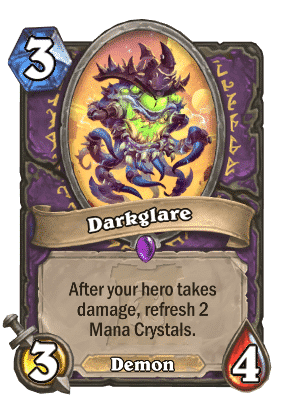
Darkglare Warlock is a self-damage Aggro deck with Darkglare serving as the centerpiece. Darkglare allows for plenty of mana cheat that helps the deck to swarm the board with overstatted minions from as early as turn 2. Molten Giant is included as the ultimate late-game, which can be dispatched from Turn 4 onward due to the massive amount of self-inflicted damage.
Remember Naga Warlock? It’s back with vengeance, hatred, and self-inflicted damage. The deck is capable of extreme power swings starting turn 3 and unlike old Naga Warlock, it can also play Loatheb on the same turn with giants as early as Turn 5. The amount of stats it can cheat out in the early game completely outclasses any other board-centric decks, while Animated Broom allows instant trades to shut down counterattacks. Sense Demons makes the deck incredibly consistent by tutoring Darkglares, which often rules out the possibility of a dead hand. It is also worth nothing that Darkglare Warlock completely crushes the former tyrant, Time Warp Mage. This places it at the top of Tier 1 for the time being.
To beat Darkglare Warlock, one must employ either high amounts of direct damage or the most powerful control tools. One weakness of the deck is inability to continue pressure after the initial swing turn, so if Loatheb is not drawn, it can be defeated by most Control decks. However, Darkglare Warlock is very flexible and can be easily teched to counter the counters. In fact, there are so much room to tinker that about 10 deck slots are up in the air. Sunfury Protectors can shut down face decks completely, while Cult Neophytes can delay board clears very early on. Alternatively, heavy amounts of damage with Grim Rally, Soulfire, Enhance-o-Mechano, and Leeroy Jenkins might be needed to close out games.
Darkglare Warlock is the new bane of the Wild and it’s extremely unlikely it will be pushed out of the meta without nerfs happening. If you want to win games, this is the deck to play. In the following months, the title of best Wild deck will be probably an arms race between Reno Priest and Darkglare Warlock, as the two decks attempt to counter each other.


Combo Reno Priest
Ranked: 2 (+3)

Combo Reno Priest is one of the most iconic decks in Wild Hearthstone. Popularized after the introduction of Shadowreaper Anduin, Combo Reno Priest assembles its combo by reducing its hero power to 0 and couple up with many cheap cards. Combo Reno Priest either plays Spawn of Shadows or Prophet Velen as its finisher, and it utilizes plenty of cycle cards to get there.
Reno Priest received an incredibly powerful card this expansion in Lorekeeper Polket. This was a complete gamechanger for the deck, as now it can consistently draw Raza and Death Knight in order to obtain oppressive late game power. Other notable cards are Raise Dead (great value and combo fuel), Pen Flinger (flexible removal and combo fuel), Wave of Apathy (anti-Darkglare tech) and Mindrender Illucia (combo hate tech). All those tools combined make the deck extremely well rounded and very difficult to counter. It’s one of the very few decks that can put up a fight against Darkglare Warlock. Wave of Apathy and early clears give it a strong arsenal to deal with early power turns. However, even Reno Priest cannot defeat turn 5 Loatheb with 3 giants.
An interesting development to note is that Time Warp Mage (which was a very bad matchup) got almost completely pushed out of the meta, so apart from Warriors, heavy counters have pretty much ceased to exist on ladder currently. All those factors combined place the deck just below Darkglare Warlock. Again, if you are a fan of winning games, you can’t go wrong with Reno Priest.



MID
Kingsbane Rogue
Ranked: 3 (+27)
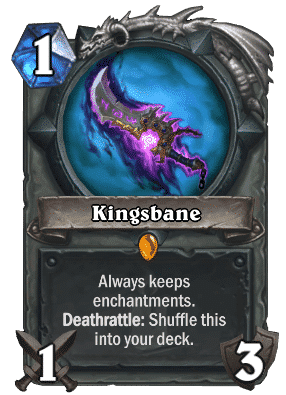
Kingsbane Rogue is a deck that revolves around buffing and redrawing its namesake card, Kingsbane, to create an infinite amount of damage that can eventually end the game. Kingsbane Rogue used to play a Mill package with Coldlight Oracle, but after the nerf to Leeching Poison, it has switched to an early aggressive Pirate package.
Kingsbane Rogue has made a huge leap forward thanks to Secret Passage, as drawing 5 cards for 1 mana might be a little bit good. Cutting Class gave the deck even more draw, so he deck is now very consistent at drawing Kingsbane, replenishing resources, and churning out repetitive damage. It is capable of beating Reno Priest and Darkglare Warlock, although how the matchups play out depends heavily on tech cards employed by the enemy. Stickyfinger in Reno Priest or Sunfury Protector in Darkglare Warlock can completely shut down the Rogue, but the Rogue can just draw well and steamroll over the opponent.
The dependency on opponents’ tech cards means that Kingsbane Rogue cannot truly take over the meta. The deck also struggles to take back board control after early turns, being solely reliant on direct damage, a plan that can be easily stopped by taunts, life gain, and faster decks. Therefore, Odd Midrange decks and Aggro Druid can bully it consistently. For those reasons it sits at Mid Tier 1.
There are two main Kingsbane build right now. The traditional version runs Pirates and many draws, while the Stealth version claims to be better against Darkglare Warlock and Reno Priest for having more consistent minion damage output. Just try out both and see which one fits your playstyle better.



![alb987 #1 Legend (Kingsbane Rogue) [made by Corbett]](https://hearthstone-decks.net/wp-content/uploads/2020/09/alb987-1-Legend-Kingsbane-Rogue-made-by-Corbett.png)
LOW
Bomb Warrior
Ranked: 4 (+13)
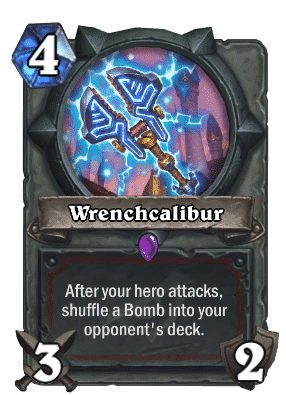
Bomb Warrior is a midrange deck that relies on damage output from cards that shuffle bombs into its opponents’ decks. It aims to seize the board with early cards like Risky Skipper and Bloodboil Brute and hold out until the opponent dies from taking bomb damage. There are many different supporting packages in addition to bombs, but the most popular version plays an Enrage package.
Bomb Warrior has stealthily climbed to Tier 1; however, new cards weren’t the main reason. Although Lord Barov and Coerce are strong cards, the real reason why this deck became a relevant player in the meta is the ability to soft counter Darkglare Warlock and Reno Priest. Risky Skipper turns are unaffected by Loatheb, while Lord Barov can wipe entire board easily. Bombs shut down Highlander cards, including Raza. However, the deck can still lose to those two powerhouses. If Raza is played before two Bombs are shuffled, Priest can close out the game before Bomb damage becomes too much. Also, versions playing Illucia, a card that’s not popular anymore following her nerf, can use up your Skippers and draws so you can’t refill and lose to counter pressure. Meanwhile, Darkglare Warlock still requires specific answers being drawn early.
Overall, Bomb Warrior is quite well rounded, but its sheer power level is not as high as top Tier 1 decks, which places it at the bottom of Tier 1. Bomb Warrior is also more easily countered by different Tier 2 and Tier 3 decks, especially ultra-fast Aggro and armor gain decks like Odd Warrior and Jade Druid. Nevertheless, if you see tons of Reno Priest and Darkglare Warlock, Bomb Warrior is a great choice for ladder and this is unlikely to change.



TIER 2
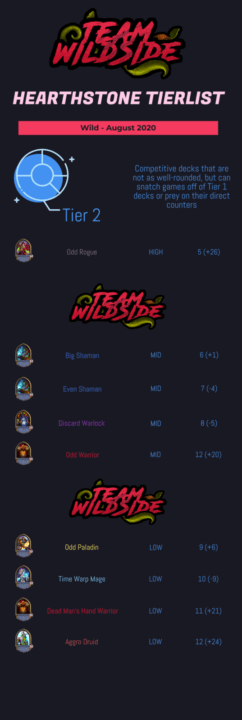
HIGH
Odd Rogue
Ranked: 5 (+26)
LOW
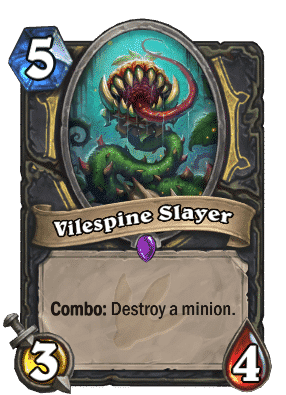
Odd Rogue is a tempo-midrange deck that gains its name for playing only odd-costed cards. Powered by Baku the Mooneater’s Start of Game effect, the Rogue gains access to a 2/2 weapon at any stage in the game. This gives the Rogue an incredibly consistent damage output as well as early board control and allows it to play a variety of synergistic Combo and Pirate cards.


MID
Big Shaman
Ranked: 6 (+1)
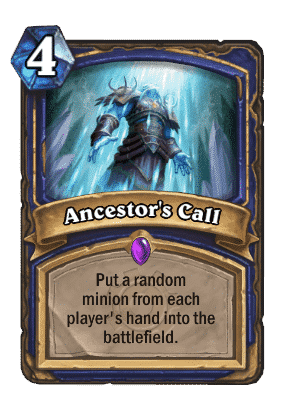
Big Shaman is a control deck that gets its name from cheating big minions. Ancestor’s Call, Muckmorpher, and Eureka! are essential to the strategy, as they allow big minions like Y’Shaarj and Scrapyard Colossus to enter play way earlier than they should. Other than that, the deck plays plenty of healing, AOEs, and removals for survival.
Big Shaman has received an incredibly powerful card in Scholomance Academy—Lightning Bloom. It enables some of the most insane highrolls in the game, allowing Y’Shaarj to be summoned on turn 1. However, highrolls aside, it doesn’t perform well against Darkglare Warlock and Reno Priest, things that are major problems in the current meta. Nevertheless, it is still great against rest of the meta, which slightly improves its overall standing in mid Tier 2.
The deck isn’t a total loss cause against the Top 2 decks, particularly Darkglare. With powerful clears like Hagatha’s Scheme and Torrent, it might actually steal a few games agaisnt Darkglare without a crazy highroll. Ancestor’s Call coupled up with a 1 mana Torrent can remove a Giant immediately, while Devolving Missiles prevent crucial revival from Raise Dead. It’s worth noting that Torrent stays at 1 mana even after a Loatheb if you’ve played a spell the turn before, so you can plan ahead if anticipate a Loatheb.
Big Shaman is the new prince of the highrolls. Such power allows it to steal a win from any deck, even if it’s not something that can be pulled off consistently. If Big Shaman can find a way to target one of the two best decks in Wild, it may just become a relevant player in the meta.


Even Shaman
Ranked: 7 (-4)
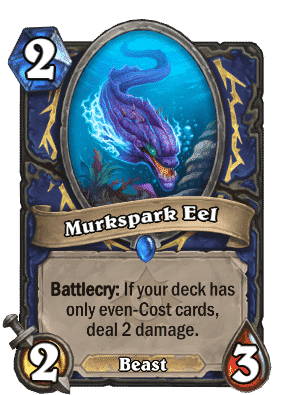
Even Shaman is the midrange deck that gets its name from playing only even-costed cards. Powered by Genn Greymane, the Even Shaman can spam early totems to power up highly-synergistic cards like Vessina, Thing from Below and Draenei Totemcarver. The deck overwhelms opponent in the mid-game with overstatted Overload card which can activate many high-tempo cards such as Likkim and Thunderhead.
Even Shaman has received some very powerful cards, namely Diligent Notetaker and Lightning Bloom, allowing it to highroll early or close out games with extra burns. However, it performs very poorly against two best decks in the format, what pushed it to mid Tier 2. It cannot handle powerful board clears of Priest nor huge board swings of Darkglare Warlock, while Bomb Warrior can also be a difficult opponent.
A few people have been trying out ultra low-curve versions with Voracious Reader and traditional version plus Lightning Bloom, but none have improved the matchups against top decks while don’t help that much in matchups where the Shaman is already good at. Fans of managing resources will be definitely saddened by Even Shaman’s fall from grace. The situation is likely to become worse and worse, as more players flock to these decks. Even Shaman will have to wait for either nerfs or a new expansion.


Discard Warlock
Ranked: 8 (-5)
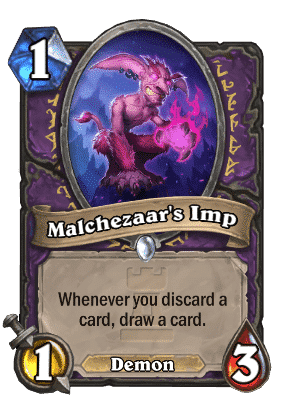
Discard Warlock is a midrange deck that aims to generate tempo through Discard synergies. While Discard cards typically sacrifice hand resources for immediate tempo, cards like Silverware Golem and Hand of Gul’dan can effectively negate these downsides. As such, the Warlock can create huge boards very early on, while Doomguard and Soulfire provides damage to finish off the game.
To think that Discard Warlock was actually the epitome of efficient early game resource unloading. The deck lacks behind Darkglare Warlock so hard now that you might as well concede when you see your opponent plays a Tour Guide on Turn 1. The strongest thing going on for Discard Warlock has always been a steady stream of pressure followed by constant hand refills, which makes it plays out less like an Aggro deck and more like a Midrange deck. And no Midrange deck is expected to consistently race Darkglare down.
It’s not all bad news, however. Discard Warlock is a decent deck into Reno Priest, probably slightly better than the boogeyman Darkglare itself, and is much better into Odd Warrior. Although Discolock has received no new cards, it’s still a very resilient deck into any slow deck, it’s just that you’re going to have trouble against the faster part of the meta.

Odd Warrior
Ranked: 8 (+24)
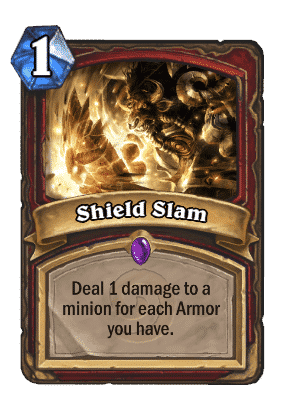
Odd Warrior is a reactive control deck that gains access to 4 extra armor every turn from Baku the Mooneater’s Start of Game effect. Odd Warrior can call upon some of the strongest removals in their arsenal in Brawl and Shield Slam, while their armor accumulation opens up synergies with various armor-related cards.



LOW
Odd Paladin
Ranked: 10 (+5)
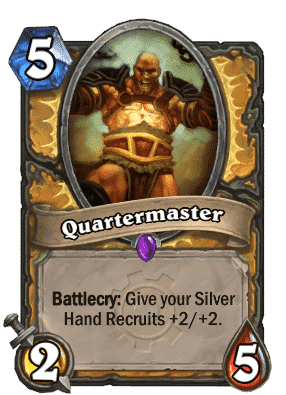
Odd Paladin is a aggressive-midrange deck which gains its name for playing only odd-costed cards. Powered by Baku the Mooneater’s Start of Game effect, the Paladin can summon two 1/1 recruits at any stage in the game. This gives the Paladin an incredibly consistent board presence that synergizes with cards like Quartermaster, Warhorse Trainer, and Steward of Darkshire.
The naysayers thought that Odd Paladin would take the meta by storm with its 1 mana 3/3 Tour Guide tempo, but turns out there are much more frightening opening these days. Even on Turn 1, a Tour Guide opener can easily outclassed by Aggro Druid’s Gibberling or Darkglare’s Pen Flinger Coin Pen Flinger. Unlike Odd Rogue, Odd Paladin no longer has a Highlander disruption like Beneath the Grounds after the Bad Luck Albatross nerf, which means Reno Priests are happy to devour the Paladin alive for supper. The inability to win a highroll race against many decks and a weak matchup into Priest restricted the Paladin’s power, tying it down to its Bottom Tier 2 spot.
Odd Paladin still retains is specialty in beating up Rogues, however. Also, the matchups against Bomb Warrior and Aggro Druid are relatively favorable, which means the deck can be used as a counter deck in very specific meta. But if you expect Odd Paladin to be a Tier 1 deck again in the near future, you will be dearly disappointed.


Time Warp Mage
Ranked: 11 (-10)
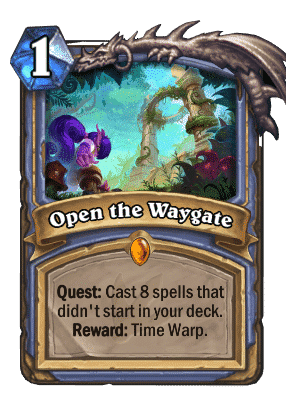
Time Warp Mage gets its namesake from the card Time Warp, the reward of the Mage quest Open the Waygate. The Mage tries to complete the quest quickly to pump out either Flamewakers, Arcane Giants, or both, and try to kill their opponents in the extra turn allowed. Archmage Vargoth is sometimes used to give the Mage another turn to comfortably set up for lethal.
The former queen of Wild is now just a shadow of herself, hiding behind the waygate and looking to sneak on the inauspicious Priests passing by. The deck saw no notable upgrade apart from Wandmaker, and it has now strayed so far behind in the highroll game that it can be destroyed by Darkglare Warlock, Reno Priest, and even Big Shaman.
Before Illucia was nerfed, Time Warp Mage was next to non-existent on ladder. But now that the Priest can no longer steal your quest reward (the ones who can do so must be insane to keep playing Illucia in the deck), Time Warp Mage finds a nice niche it can exploit. In the hand of a seasoned veteran, it is still capable of reaching really high ranks, and its highroll potential is still nothing to whiff at. But you best steer clear from the deck if you see too many Darkglares.



Dead Man’s Hand Warrior
Ranked: 12 (+20)

Dead Man’s Hand is a fatigue-style deck that cheeses out win by outlasting opponents, exhausting their resources, and cheating fatigue by shuffling unlimited cards. Brann and Coldlight are often used to refill the hand, while signature defensive cards like Brawl, Shield Slam, or Risky Skipper helps stabilizing until you get there.


Aggro Druid
Ranked: 13 (+23)
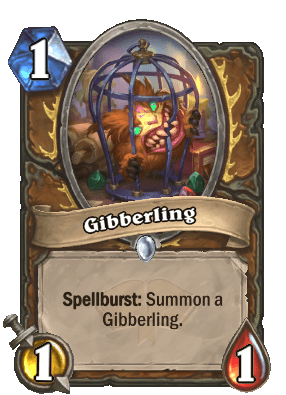
Aggro Druid is a typical Aggro deck that aims to win very early on by playing very cheap and efficient minions. The deck can fill the board really quickly and end the game with board buffs like Power of the Wild and Savage Roar. The most recent versions also use Embiggen to pump overstatted minions on board.
Aggro Druid has evolved into one of the most highrolly decks in the game. In a sense, it’s like a mini-Darkglare Warlock that goes off much earlier, around Turn 1 or 2. Either you clear the board by then, or you die a horrible death. With the inclusion of Gibberling, the Druid player can fill the board much really early on using a few spells. Embiggen is still kept for free 3/3 Patches and 4/4 Parachute Brigands, and the rest of the deck is still pretty much the same.
While very weak into Reno Priest and different flavors of Control Warrior, Aggro Druid is very serviceable against Darkglare Warlock. It can flood the board much earlier than Darkglare, and naturally plays counter cards like Nerub’ar Weblord and Cult Neophyte without sacrificing early game power. The good matchup against Darkglare gives Aggro Druid just a big enough edge for it to squeeze itself into Tier 2.



TIER 3

HIGH
Pirate Warrior
Ranked: 14 (-11)

Pirate Warrior is a weapon-based aggro deck that relies on a strong early game Pirate synergy to create recurring damage with pirates and weapons. Ship’s Cannon into pirates provide consistent damage, while the Warrior is also capable of cheesing wins with late-game chargers like Leeroy Jenkins and Kor’kron Elite.
Pirate Warrior suffers from the same problem as many other Aggro decks barring Aggro Druid: it can’t compete against Darkglare Warlock. It doesn’t get on board quickly enough, and a Nerub’ar Weblord tech is impractical in a deck that plays as many battlecries as Pirate Warrior. Some players have tested around with Voracious Reader so they can play weapons with higher damage output than Death’s Bite, but that card alone is nowhere near enough.
As Corsair Cache now only increases durability of weapon by 1 without boosting the attack. the Pirate Warrior isn’t really that great in controlling the board early on anymore, while losing plenty of damage against Control decks like Priests. The rise of Odd Warrior also hampered the deck a good deal. All things combined, Pirate Warrior got sent all the way to Tier 3.


Secret Mage
Ranked: 15 (-4)

Secret Mage is a variant of Aluneth Aggro Mage. It seizes control of the board in the early game by playing discounted secrets along with highly synergistic secret build-around cards. The deck has the ability to both tutor secrets and deal burn damage, while Aluneth provides a way to utilize all of its value in the most tempo-efficient manner.
Secret Mage used to dominated the meta after Saviors of Uldum gave it the boost it needed with cards like Arcane Flakmage and Cloud Prince, but has since struggled to find its way near the top due to aggressive strategies gaining more tools and players getting much better at playing around the secrets. It also didn’t receive any new card apart from the occasionally-awkward-to-play Polkelt, which makes it so it becomes much harder to burn down the Priests and Warriors. Aluneth is also a huge gamble in an Ooze/Stickyfinger meta.
Nevertheless, Secret Mage is an okay choice as it can still win any games with the right secret combinations. Darkglare Warlock is also not a bad matchup, as a deck getting itself down so low that often is bound to be vulnerable to burn.

Odd Demon Hunter
Ranked: 16 (-8)
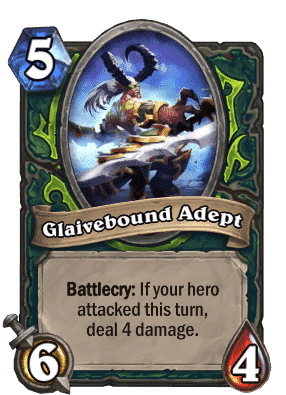
Odd Demon Hunter is a hyper-aggro deck from the newest class in Hearthstone—Demon Hunter. With a plethora of odd-costed early minions that synergizes well with the 1-mana hero power, the deck tries to overwhelm its opponents in the early game. Battlefiend, Lowly Squire, and Satyr Overseer are a few staples in the deck, while Glaivebound Adept and Priestess of Fury serve as finishers.
Odd Demon Hunter received the same fate as Pirate Warrior. It didn’t get impactful enough additions, and is now struggling to keep up the pace against all the new powerhouses.
The way to build Demon Hunter now seems to be to flood it with one drops like Demon Companion and Intrepid Initiate. Intrepid Initiate is actually a really good card in a deck filled with cheap spells like Demon Hunter, acting as yet another Battlefiend or Lowly Squire. A consistent early game combined with the potential to lock out Darkglare turns with a well-timed Mana Burn gives the deck a fighting chance on ladder. Pen Flinger is another potential source of damage, as it offers extra damage between uses of cards like Twin Slice. Just remember to not queue into Control Warriors or Priests and you might climb with this deck.



Malygos Druid
Ranked: 17 (-4)
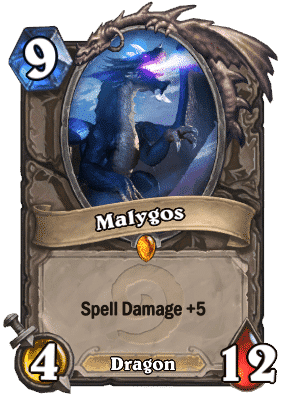
Malygos Druid is a combo deck that revolves around cheating Malygos onto the board and dealing overwhelming damage to the opponent. Several cards can enable a very cheap Malygos, including Aviana and/or Dreampetal Florist.

Jade Druid
Ranked: 18 (-7)
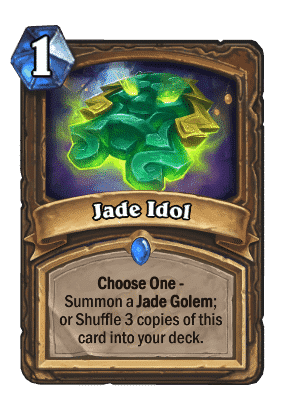
Jade Druid is a Control-Fatigue deck that aims to outlast its opponents by generating infinite Jade Golems. Jade Idol allows for this Fatigue-heavy playstyle, while access to various stall cards and board clears like Malfurion the Pestilent, Poison Seeds, Ferocious Howl, and Spreading Plague means the Druid can often comfortably get there. The deck reloads by lategame card draws such as Ultimate Infestation and Overflow. Jade Druid can comfortably go to fatigue, but oftentimes it just wins by surviving.
With Sunstrider now nerfed, players are now trying out different versions, notably the Dragon package with Crimson Hothead and Ysera, the Guardian Animals package, or replacing Kael’thas with Ysiel. But all of these packages suffer from the same problem: Jade Druid is soooo slow. It can’t keep up with the current meta at all, to the point that Jade Druid is often outpaced by the ‘slowest’ decks like DMH Warrrior or Reno Priest.
The different versions of Jade Druid are good against different decks. While a Dragon package is better against Aggro due to being able to play Oaken Summons, and against Priest & Warrior because of Ysera, the Guardian Animals version can beat up Midrange decks effectively with Runner pressure. The Ysiel version can help you get out of tricky Loatheb board locks, as an Ysiel from Barnes turn all your spells from 15 mana to 1 mana in cost. The difficult thing here is to find out which version of Jade Druid you should play on ladder.



Libram Paladin
Ranked: 19 (+17)

Libram Paladin is a Midrange deck that utilizes the synergies between Libram cards to out-tempo and outvalue the opponent during the mid-game and late-game stages. Libram Paladin typically plays only Paladin cards to take advantage of a Pure package, or play a Molten Thekal package that can hit face for 20 damage with Holy Wrath.
Libram Paladin is legit, but it might not be the deck you think it is. The Libram Pure Paladin has always been a decent deck, tested thoroughly by players since last expansion. With new cards like Devout Pupil to aid the Pure package, the Pure version is very good at stabilizing and seizing control in the mid-game, making its matchup spread incredibily solid, with the exception of two decks. Darkglare Warlock and Reno Priest. Yeahhhhhhh, so you might imagine why this is a problem for the deck.
Fear not, however! For our scientists have discovered a new, potentially superior build of Libram Paladin! Turns out that the payoff of the pure cards isn’t all that good in Wild, and it might just be better to include Molten Giant and Thekal for the occasional highroll… and more. This is where Lorekeeper Polkelt enters. He reorders your deck so your Holy Wrath always hit Shirvalla or Molten Giant. You can either execute this on Turn 9, or better yet, right on Turn 4 and 5 with a delayed Holy Wrath. This almost guarantees a victory against any deck if you have a solid enough opening, which happens regularly enough with Libram Paladin. We think that Libram Paladin might be the sleeper broken deck this expansion, and we don’t mind to be proven right.


CLASS META RANKING

WARLOCK
RANK 1 – 332 POINTS
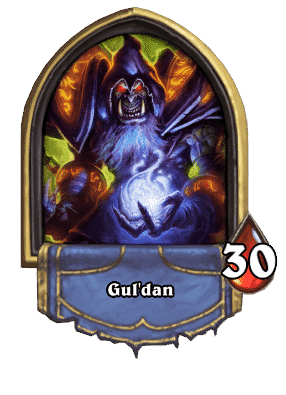
The transition of the King is completed. It took several seasons for Gul’dan to go from a grindy class to an exceptionally explosive one, and Darkglare Warlock was the catalyst of this swift transformation. The main problem might be with how Warlock as a class is designed. With a broken hero power and multiple mana cheat mechanics, it is very unlikely that Warlock will become irrelevant at any point in the future.
Darkglare Warlock is omnipresent. It is not unusual to have half of your games (or even 80% in extreme cases) being against this insanely efficient deck. While whether the deck is stronger than Reno Priest is a topic of debate, it’s undeniable that the deck can end games extremely quickly, and for climbing Legend, speed is everything. We don’t think that the deck is strong enough to warrant a nerf from its power level alone, but we have also seen plenty decks getting nerfed from being unfun to play against.
Now, let’s turn to the other Warlock decks. Discard Warlock has moved to the backstage; variants of Cubelocks is staying as far away from the limelight as possible; and Mecha’thun is now running a postal service directly back to the Outland where they were relevant. If you’re sick of playing Darkglare Warlock, Discard Warlock is not a bad choice for its decent matchup into Reno Priest and Bomb Warrior. The downside is that you might be barely playing any new card, but so won’t you when playing Cubelocks. And you won’t be winning with Cubelock.
Reno Warlock is a deck with some potential. The ability to play Finley and Grizzled Wizard gives it a fighting chance against Priest, and if you can survive until Turn 7 against Darkglare, a Lord Godfrey is often enough even with a Loatheb. For now, it stays at the bottom of Tier 3.
While still being the strongest in the whole game, Gul’dan’s saw a plummet of 188 points from just last month. Its point total is even lower than the 5th strongest class last month. Warlock is also one of the most ‘diversed’ class in this expansion, with a total of 5 playable decks. So much for diversity.
WARRIOR
RANK 2 – 280 POINTS
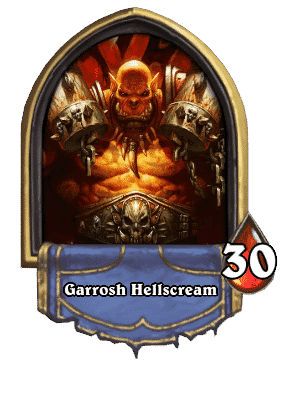
Warrior—the anti-meta class—has been a big winner of the meta, capitalizing on a shrink in the number of top decks. Garrosh has always been good at tailoring his decks to defeat a few specific enemies, and now when the list of decks to beat is only three (Darkglare Warlock, Reno Priest, and Kingsbane Rogue), the task became significantly easier. All the good decks that Warrior has right now can skew the matchup against at least one of these top decks into clear favorables, while the deck that hasn’t managed to do so (Pirate Warrior) falls on the wayside.
The rise of Bomb Warrior might be surprising to some people, but it’s ultimately the natural development of the meta. A deck that can be tech-ed to win against the two most oppressive decks in the meta is bound to find a foothold. Bomb Warrior typically struggles against traditional Aggro decks, but can push enough damage against Darkglare Warlock before their blowout turns (or just Barov them). The matchup against Priest is favorable, because of obvious reasons. If these two decks somehow disappear from the meta, Bomb Warrior will fade along with them, but for now it seems very unlikely.
Dead Man’s Hand Warrior and Odd Warrior are also plying their trades on ladder, doing the same thing Bomb Warriors do: attempting to counter the ladder. While these decks often don’t stand a chance against Reno Priest, they beat Darkglare Warlock and Rogues more often with the right tech. Compared to Bomb Warrior, each of these archetypes have glaring weaknesses, though. With Dead Man’s Hand Warrior, it’s consistency; while with Odd Warrior, it’s inflexibility.
Pirate Warrior is still a good Aggro deck, but it didn’t receive any support. Just like Odd Demon Hunter, the other premier Aggro deck last expansion, Pirate Warrior fell to the Top of Tier 3. It’s efficient at what it does, but not nearly efficient enough in the era of Flesh Giants turn 3. Pirate Warrior is awaiting a nerf this oppressive Warlock deck, and this might be a really long wait.
Galakrond Warrior is incorporating the same Bomb package as Bomb Warrior, but it cannot deal with Warlocks nearly as well. Galakrond Warrior stays at the bottom of Tier 3 for now.
ROGUE
RANK 3 – 275 POINTS
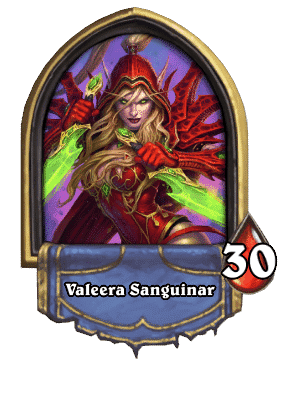
Valeera made a grand comeback in Scholomance Academy, jumping all the way from the 9th position to just behind Gul’dan and Garrosh. The class has received arguably the biggest mass of playable cards in Wild, which undermines its success story to a degree. Nevertheless, being able to wreak havoc in a meta of Priests and Warlocks is an accomplishment in its own, even if Rogues only serve as the third-wheeler most of the time.
During the first couple days of the expansion, Kingsbane Rogue saw the amount of play that Darkglare Warlock is seeing now. But when players realized that there’s an even better hyper fast deck that doesn’t run out of cards or automatically lose to a Stickyfinger, they jumped ship. Kingsbane Rogue still has a place as they can beat both Warlocks and Priests given a good hand. But the more we play it, the more we realize how dwindling the deck is compares to the Big 2.
Odd Rogue—the only deck inside Top Tier 2—would have been a better choice than Kingsbane Rogue if only Darkglare didn’t exist. The deck can comfortably tech for Reno Priest, Kingsbane Rogue, and other Aggro, while is much more resilient against Bomb Warriors than its cousin.
PRIEST
RANK 4 – 240 POINTS
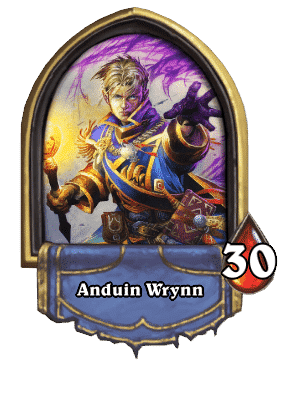
Anduin has only climbed to Rank 4 in this meta snapshot. While Reno Priest is a major contender for the best deck in the game, it’s also the only relevant Priest deck. This puts Anduin in a major disadvantage, as class meta ranking is a team game. Every single class above Anduin has at least two good decks inside Tier 1 & 2 to boot, while Anduin’s reinforcements are all Bottom Tier 3 at best.
There’s not much else to say about Reno Priest. We’ve predicted the deck to hoard the ladder for itself as soon as Time Warp Mage steps down from the throne, and it’s on its way to do just that. Reno Priest is favorable or even against the majority of decks on ladder, even the oppressive Darkglare Warlock, and only folds to specific counter decks (as all decks should). However, as Reno Priest keeps reigning the meta ever since the Raza unnerf, we start to worry that the deck will stay at the top for too long, which restricts play experience as a whole and class diversity for Priest specifically. Wild wouldn’t be a fun format if you faced 50% Reno Priest year after year.
Other Priest decks show sparkles of potential, but none of them have blazed into meta contenders yet. Inner Fire Priest can combat on board better now that Power Word: Feast heals the minion immediately, but board combat is pretty much useless in this meta. It can also win games versus Control deck by playing Mindrender Illucia and locking their answers, but with Illucia nerfed to 3 mana, it will take a lot more planning to achieve this flawlessly. Big Priest with a defensive package does okay against Darkglare, and one with more late game can beat Reno Priest semi-regularly, but you can’t really do both. Control Reno Priest with a Togwaggle top end or simply slow grindy cards can win with the right tech cards, but you are probably better off playing Spawn of Shadows anyway.
SHAMAN
RANK 5 – 179 POINTS

You should’ve stopped at Priest. You have now official passed the territory of relevant classes and walked into the land of the meta lurkers. Thrall the Diamond 5 Gatekeeper stops you at the entrance, demands to see your ID, then denies your access because you are a filthy Darkglare spammer. You protest, claiming that you’ve been playing the Tier 1 Even Shaman all your life. Thrall smirks; his glinting eyes pierce right through your soul as he says: “We Shamans haven’t been Tier 1 ever since the Scholomance Academy reopened. Don’t think you can fool me, interloper.”
Shaman has managed to stay somewhat relevant, with two decks in the middle of Tier 2. However, when we look at play rate, there seems to be another narrative at play here. Both Even Shaman and Big Shaman takes a really small portion of the meta. Both of these decks didn’t get enough support, couldn’t outrace Darkglare Warlock, couldn’t add enough pressure against Reno Priest, and simply wasn’t attractive enough. Lightning Bloom is the common addition in both of these decks, but 2 free mana a turn pales in comparison with 10 from Darkglare. Cards like Diligent Notetaker, Manafeeder Panthara in Even Shaman, and Sphere of Sapience in Big Shaman also don’t do anywhere near enough.
However, both these decks have potential to counter the top decks. For Big Shaman, Hagatha’s Scheme can clear a Giant board if they come down late enough, and Torrent might be able to remove individual Giants if planned right. Cards like Frost Shock are also being employed to stall through a Loatheb turn, the make-or-break turn for a Control deck. Against Reno Priest, a Hakkar might often be enough to shut down most of their cards if cheated out early. For Even Shaman, Nerub’ar Weblord and Cult Neophyte can be played to pressure the Darkglare player while you’re trying to get the seize control of the board.
After months of lingering on to Tier 3, Shudderwock Shaman and its cousin, Reno Shaman, have been erased from existence. On the contrary, Aggro Shaman has sprouted from its seed and is slowly assembling itself to become a legit deck. Diligent Notetaker provides much needed gas for this deck, while Speaker Gidra can be a very threatening presence early on. Either to fuel a Spirit of the Frog draw turn or to cheat out stats early, Aggro Shaman makes use of Lightning Bloom very well. We have hope for this archetype going forward.
Odd Shaman is a rather odd deck that has been buffed a little with the inclusion of Tour Guide and Instructor Fireheart, but it still lacks some substance to become an actual viable deck. Maybe more cards that actually synergize with the hero power might help with that.
MAGE
RANK 6 – 150 POINTS
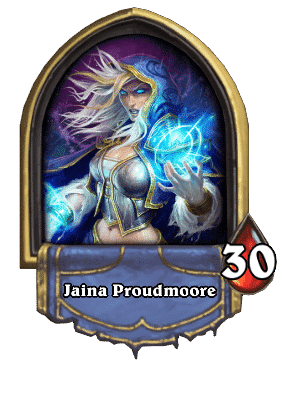
THE WITCH IS DEAD! Well, not really, but Jaina is barely alive and gasping for air. The upgrades to the Top 4 classes have left Mage behind in the highroll race. While Time Warp Mages still needs to wait until around Turn 4 to start going off, decks like Darkglare Warlock or Aggro Druid might already kill them by then. Furthermore, many decks are play Nerub’ar Weblord and Cult Neophyte as a response to Darkglare Warlock, and Time Warp Mage, Reno Time Warp Mage, and Reno Galaxy Mage all suffer as the collateral damage.
Variants of Time Warp Mage still bullies Priests, especially after the nerf to Mindrender Illucia,. It’s still a good counter deck to old Control decks, but that’s all it is now. The deck can’t race against Aggro enough to save its life, and the odd highroll wins are in no way enough to make up for the losses. The fate of Galaxy Mage is even worse, as the deck has all but disappeared from ladder.
Secret Mage is in a tough spot. It no longer has enough damage to kill the Reno Priest, especially when they pack multiple weapon removals for the Warrior and Rogue matchups. Polkelt is also not as effective in this class, as the Secret Mage will have to forego tempo from secrets for one burn at a time after playing the card, which makes an Aluneth topdeck much weaker. Still, it wins against Darkglare Warlock often enough to stay somewhat relevant, but don’t expect too much from this mediocre deck.
As players look for worthy successors of Time Warp Mage, they came to Standard for inspiration and brought back Tortollan Mage and Mozaki Mage. Both decks keep the spirit of their Standard counterparts while sprinkle in upgrades like Ice Block, Meteorologist, and Wild exclusive cheap spells. It’s interesting to see the direction these decks will head in the next coming months.
DRUID
RANK 7 – 132 POINTS
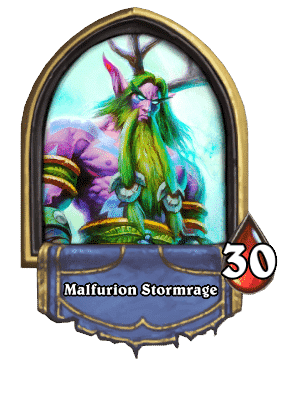
Druids were somewhat decent at the beginning of the expansion, before Blizzard decided to nerf Kael’thas yet again. Now, Malfurion’s slow decks are a tad too slow. At least Druids haven’t been completely cast aside yet, as Aggro Druid is still keeping the class relevant despite all the setbacks.
Aggro Druid is one of the few Aggro decks that can still function properly alongside Darkglare Warlock, and much of this has to do with Darkglare Warlock themselves. The specific tech cards don’t hamper the Druid’s gameplan while tip the scale of the matchup against Warlock to somewhat favorable. Aggro Druid is another counter deck you can play when you’re not sure which deck to play, because it doesn’t have any auto lose matchups, a characteristic not often seen in Tier 2 decks right now.
Malygos Druid is like a Time Warp Mage but weaker, and this is especially true after the nerf to Kael’thas. The deck now has no ability to race against Aggro, which might lose it quite a few percentages against Rogues. A saving grace to this deck is that Priests have begun to cut Illucia from their deck, which means it is impossible for them to stop or slow down the Malygos combo turn. Togwaggle Druid is even slower and less reliable, and players should steer clear from this deck if tempted.
Jade Druid is just slow and clunky. Much of its lifeline has been in the hand of Kael’thas, who produces early blowout turn against Aggro and gives the Druid hope to outrace Darkglare, if at all. Now Druid has to go back to playing Vargoth and Oaken Summons, which isn’t nearly enough. Jade Druid also can’t put pressure on Priests anymore, which means they can only tank up, lie still, and take blows from Anduin. Not the best strategy if you look at how Odd Warrior fares against Priests.
The only “new” deck this expansion from Druid is a Taunt Druid, using a new engine called Guardian Animals to aid Hadronox. It ditches the unlimited Undatakah package that’s now ineffective due to how few Cubelocks there are on ladder, which gives it a decent fighting chance against Aggro. Unfortunately, this deck beats neither Darkglare or Reno Priest, which means it’s next to useless at high ranks.
PALADIN
RANK 8 – 85 POINTS
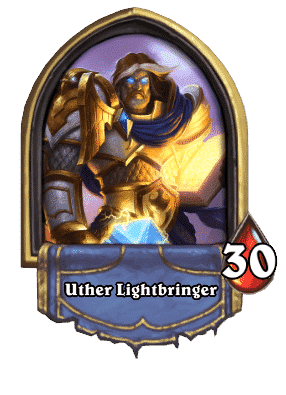
Remember how hyped people were for Odd Paladin, seeing Tour Guide being released? Well, turns out it’s good in so many other decks as well, being a Neutral card and all. At least Odd Paladin saw some great upgrades. Other Paladin decks barely sees any, which is why Uther is in such a tough spot right now.
Odd Paladin is one of the best Midrange decks right now, but it doesn’t matter when Midrange sucks. Almost no midrange deck can reliably contest Darkglare Warlock, and in the case of Odd Paladin, it gets so hopeless that some people even played Lord Barov to try and get favorable trades (and that didn’t go too well). However, as mentioned time and time again, Odd Paladin is still an extremely resilient deck which has gotten some juicy boost. If only this isn’t a Warlock and Priest world.
Libram Paladin is a fairly resilient deck against many Control and Aggro decks, but its fatal weakness against Reno Priest often proves to be too much to overcome. It’s slow and passive playstyle often puts almost zero pressure to the Priest before the very late game, and that’s very possibly the biggest death sentence in this matchup. However, we personally think this archetype has plenty of potential. Our very own RenoJackson decided to ditch the Pure package which didn’t yield much gain in Wild to go for Thekal, Molten Giant, Polkelt, and… Holy Wrath. The deck is surprisingly consistent in dealing 20 damage for 5 mana, or just occasionally get a Molten Giant down for free. Half a Darkglare board for mana and 3 cards is pretty good.
Mech Handbuff Paladin has really fallen by the wayside. It’s received no new cards, and cards like Animated Broomstick and Neru’bar Weblord alone are not enough for Handbuff to branch out to a new archetype independent to Mechs. We expect this deck to slowly fizzle out, if it hasn’t already.
DEMON HUNTER
RANK 9 – 30 POINTS
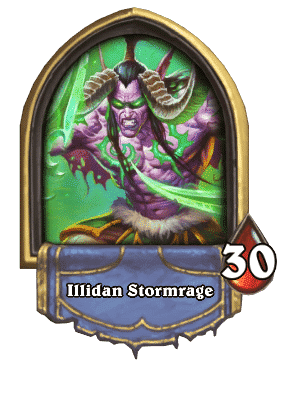
Illidan has one playable deck. One. And he’s still better than another miserable guy in the list. Odd Demon Hunter is the only Demon Hunter deck that can provide a stern test for meta decks, and even it needs specific metas to thrive. Demon Hunter is all but dead on ladder, and you only see Illidan popping up here and there, accompanied by his most devoted disciples.
Odd Demon Hunter is one of the few Aggro decks that might beat Darkglare often enough, with its very aggressive start and Mana Burn to lock out a Darkglare turn. This matchup and the matchup against Rogue makes it the most reliable Demon Hunter deck at the moment, or at least as reliable as High Tier 3 can get. It’s very difficult to win games against Reno Priest, Shaman, and Odd Warrior, so if they make up a large portion of ladder we advise you to switch class.
The Soul Fragment package is doing fairly well in Standard, but our judgment hasn’t failed us that it’s just nowhere near up to par in Wild. It’s too slow and a bit Control-ish, and the incremental burn playstyle has never made it in a format where Reno Jackson is a thing. Even the best incremental burn decks like Odd Hunter and Aggro Shaman suffers a great deal, and decks that somewhat succeed in doing so like Secret Mage needs to have a really solid early game. Soul Demon Hunter possesses neither of these.
A few people have joked around about how you can just put together a Demon Hunter deck full of counter cards like Neru’bar Weblord then squeeze in draws like Voracious Reader and Glide to somehow get there. The idea sounds underwhelming, but there have been players who actually tried this deck on Legend ladder to mediocre success. Aggro Demon Hunter might need a few more expansion for a critical mass of cards is printed, so there will be better Even-costed inclusions.
HUNTER
RANK 10 – 25 POINTS
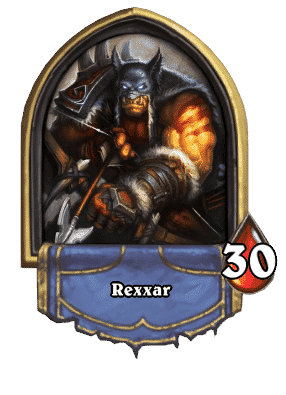
This class doesn’t exist.
In all fairness though, props to RenoJackson and all the Hunter enthusiasts out there. We have no idea how they piloted Hunter to Legend month-in, month-out, let alone high legend, but they managed anyway. There are so few playable Hunter decks out there that we can write about them in a single paragraph, but we will pay attribute to Rexxar by categorizing his mishmash of amorphous concepts of what he calls his decks into ‘hopeless’ and ‘at least has some potential’.
Beast Hunter, Reno Hunter, and most other Hunter archetypes fall into the ‘hopeless’ bunch, unfortunately. These decks can’t ever race Darkglare Warlock, can’t pressure Reno Priest, folds to Warriors, and don’t even beat generic Aggro often. There’s not much to expect from them.
The only deck we see any glimpses of hope for Hunter is Even Hunter, a deck that can comfortably tech in two copies of cards like Golakka Crawler, Snipe, and Nerub’ar Weblord to counter the more aggressive side of the meta. In fact, Even Hunter is actually rather apt at doing this. A simple Rexxar tech can help the Hunter outvalue the most resilient Warrior. The matchup against Priest is a true nightmare, but you don’t expect a Hunter deck to be able to do everything, do you?
If there remains to be no changes, we expect Hunters to stay at the absolute bottom for another expansion cycle, spamming 1-mana hero power hoping they’d eventually get anywhere. Good luck.
Deck Codes (other Decks)





























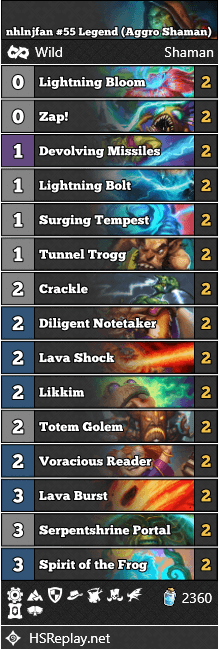


![paradox #1 Legend (Mecha’thun Darkglare Warlock) [deck by Soda]](https://hearthstone-decks.net/wp-content/uploads/2020/09/paradox-1-Legend-Mechathun-Darkglare-Warlock-deck-by-Soda.png)







You might also be interested in...
- Phone vs Tablet: Which Should You Use for Gambling in Online Casinos? November 24, 2025
Submit your Top 500 Legend Build, be seen by thousands of people!

